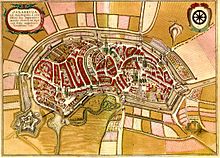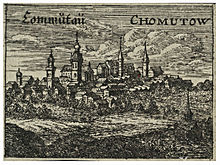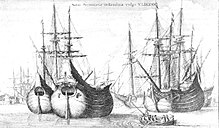Wenceslaus Hollar

Wenceslaus Hollar (born July 13, 1607 in Prague , † March 25, 1677 in London ), also Wenceslaus or Václav Hollar , was a Bohemian draftsman and engraver who spent most of his life in England.
In his time, Hollar was one of the most important representatives of his genre and was one of the first to make the technique of color etching known in England. He left behind a large number of works that are valued to this day for their attention to detail and careful execution.
Life
Childhood and youth
Wenceslaus Hollar's youth fell in the early years of the Thirty Years' War . He came from a wealthy, Catholic family of civil servants from Bohemia, which became impoverished in 1621 after Prague was retaken by troops of the emperor and the Catholic League . Originally intended to study law, the young Wenceslaus decided to pursue an artistic career at the age of 18.
First years as an artist



In 1627 the German-speaking Hollar moved to Frankfurt am Main , where he did an apprenticeship with Matthäus Merian , the most famous copper engraver of his time. During his time in Frankfurt, Hollar worked on Merian's topographies, among other things . After 1630 he stayed in Strasbourg , Mainz and Koblenz . Hollar was one of the first artists to find the landscape of the Rhine Valley to be particularly picturesque. He captured cities, castles and the nature of the Rhine Valley in numerous illustrations and thus became an early forerunner of Rhine romanticism .
In 1633 Lord Thomas Howard, Earl of Arundel , who was on his way to Emperor Ferdinand II as the English envoy , became aware of him in Cologne . The encounter with Arundel, one of the most important English art collectors and patrons of his time, was to be decisive for Hollar's future life. He accompanied the Earl of Arundel first to the imperial court in his hometown Prague, later to Vienna and on extensive journeys throughout Central Europe. Back in Cologne, he published his first book with engravings in 1635. When his sponsor returned to England in 1637, Hollar followed him to London, where he spent most of his subsequent life.
Moved to England
Hollar initially lived in Arundel's household, but did not work exclusively for him, but also for publishers and printers who, however, paid him poorly throughout his life. As an inexperienced foreigner, largely without connections, he repeatedly had to accept fees that were far too low. In his first year in England he created a large view of Greenwich for the publisher Peter Stent , for whom he also worked frequently in the years to come, which he rewarded with only 30 shillings per printing plate. Hollar later set its price at 4 pence an hour; he measured his working hours with an hourglass.
On July 4, 1641, Hollar married Margaret Tracy († March 10, 1653), a partner of Countess Alantha Arundel. With Margaret Tracy he had two children, the son James (* 1643) and a daughter. When the English Civil War broke out in 1642 , the Earl of Arundel, who had been en route again as envoy, did not return to England. Hollar therefore entered the service of the Duke of York , also worked for King Charles I and was briefly teacher to the Prince of Wales, who later became King Charles II.
As a supporter of the king, Wenceslaus Hollar finally joined a royalist regiment and was captured by parliamentary troops during the siege of Basing House in 1645 . After a short time, however, he managed to escape. In Antwerp that same year he met again with the Earl of Arundel, who died in 1646. In the next few years he created some of Hollar's best works, Dutch cityscapes as well as seascapes and depictions of nature. In 1652 he returned to London. On July 3, 1656, he married Honora Roberts for the second time. He had several children with her.
Late years
In the following years numerous books with illustrations by Hollar appeared, including classic editions by Homer , Virgil and Juvenal . Little business-minded, Hollar also sold these works far below their value, so that he lived in poor conditions. Even the restoration of the monarchy under King Charles II did not improve his situation, as he hardly received any orders from the court.

A severe blow of fate struck him in 1665 when his son James, who showed a remarkable talent for drawing, died at the age of 22 during the Great Plague of London . The following year Hollar witnessed another disaster, the Great Fire of London . Hollar had already created numerous views of the city in previous years, thanks to the accuracy of which one can still get a picture of medieval London, which was destroyed in the fire. After the conflagration, he made other representations that are still known today, including topographies that indicated the destroyed parts of the city. Their quality may have moved the king to send him on an expedition to Tangier in 1668 . There he made detailed drawings of the city and its fortifications, which Charles II took possession of as a dowry from his wife, the Portuguese Princess Catherine of Braganza. On the way back, his ship was involved in a skirmish with Algerian pirates, which he later also captured in pictures.
After his return he lived another eight years. He worked tirelessly and created a large-format work in 1670 with an Edinburgh engraving . He died in extreme poverty and it is said that his last words were addressed to the bailiff: He asked that his deathbed not be seized. Wenceslaus Hollar was buried in St Margaret's Church in Westminster on March 28, 1677 .
Artistic creation

Wenceslaus Hollar was not only one of the best, but also one of the most industrious artists of his time. His work includes around 400 drawings and over 3000 etchings . He is known to have made more than 2,700 printing plates for engravings. His work is characterized above all by absolute accuracy, attention to detail and an almost documentary realism.
Hollar was interested in an inexhaustible variety of subjects. He was best known for his topographies as well as his landscapes and cityscapes from Germany, Bohemia, England, the Netherlands, Switzerland and today's Morocco. In addition, there were portraits of saints and well-known people of his time, depictions of themes from the Old and New Testaments , mythological and historical scenes, but also coats of arms , caricatures , pictures of animals and plants, still lifes , allegories , depictions of clothing fashions and much more.
In addition, Hollar made prints of works by famous artists, which could thus be made known to a large audience. A copy of the “Virgin and Child” by Albrecht Dürer , who strongly influenced Hollar's sense of art, is one of his earliest known works from the years 1625 and 1626.
Based on the model of the "Pictures of Death" by Hans Holbein the Elder. J. Hollar created a dance of death in 1644 , which was first printed in London in 1651. Most of the 30 etchings are signed W. Hollar fecit . All representations are provided with Latin texts from the Old or New Testament . Their strikingly decorative frames show symbolic figures and symbols of transience, which were designed by the Antwerp painter and graphic artist Abraham van Diepenbeeck .
The most important collections of Wenceslas Hollar's works are now in Windsor Castle , the British Museum in London, the Hollareum of the Czech National Gallery in Prague and the Fisher Library at the University of Toronto . An extended illustrated catalog raisonné, published by Hollstein, appeared in 2009/10.
Appreciations and honors
Hollar's life and work were also taken up in literature, for example in the extensive story Das Elefantenblatt (1962) from the volume of stories of the same name by Johannes Urzidil or in the novel Dobrá kočka, která nemlsá (1970) by Miloš Václav Kratochvíl .
In the Cologne district of Lindenthal , a street was named after Hollar, and in 2003 the asteroid (46280) Hollar, discovered by astronomers at a Prague observatory, was named.
Works
- The dance of death . Coxhead, London 1816 ( digitized version ) (in German: Dance of Death )
- Wenzel Hollar (1607–1677), Travel Pictures from the Rhine , Catalog Landesmuseum Mainz 1987
literature
- Vladimir Denkstein: Wenceslaus Hollar , New York 1979 (biography: English version of the Czech original, Prague 1977) ISBN 0-913870-94-3
- Eugen Dostál: Václav Hollar , Praha 1924 (number b / w plate, French introduction)
- Michael F. Feldkamp : Comments on the city map of Osnabrück by Wenzel Hollar from 1633 , in: Osnabrücker Mitteilungen 88 (1982), pp. 230-233 (summary on the Internet: [5] ).
- Antony Griffiths et al. Gabriela Kesnerova (Ed.): Wenceslaus Hollar. Prints and Drawings from the Collections of the National Gallery, Prague, and the British Museum, London , London 1969 ISBN 0-7141-0787-5
- Hans Mielke: Wenceslaus Hollar. Etchings and drawings from the Berlin Kupferstichkabinett , ed. from the Staatliche Museen Preußischer Kulturbesitz ISBN 3-88609-128-7
- Gustav Parthey: Wenceslaus Hollar. Descriptive directory of his copperplate engravings , Berlin 1853
- Richard Pennington: A Descriptive Catalog of the Etched Work of Wenceslaus Hollar 1607-1677 , Cambridge University Press 2002 ISBN 0-521-52948-4
- Berthold Roland (Ed.): Wenzel Hollar (1607–1677): Travel pictures from the Rhine. Cities and castles on the Middle Rhine in drawings and etchings , exhibition catalog, Mainz 1987
- Werner Schäfke (Ed.): Wenzel Hollar - The Cologne Years. Drawings and etchings 1632–1636 , Cologne 1992
- Gillian Tindall: The Man Who Drew London. Wenceslaus Hollar in Reality and Imagination , London 2003 ISBN 0-7126-6757-1
- Johannes Urzidil : Wenceslaus Hollar. The Baroque engraver . With the collaboration of Franz Sprinzels . Vienna u. Leipzig, Passer 1936.
- Johannes Urzidil: Hollar, a Czech émigré in England . Translated by Paul Selver , London, Czechoslovak, 1942.
- Jirina Volková: Hollar von Prahenberg, Wenzel. In: New German Biography (NDB). Volume 9, Duncker & Humblot, Berlin 1972, ISBN 3-428-00190-7 , p. 539 f. ( Digitized version ).
- Wenceslaus Hollar (1607-1677). Etchings from the Kupferstichkabinett of the Staatliche Kunsthalle Karlsruhe , Karlsruhe 1990 ISBN 3-921524-56-3
- Bernhard Grueber: Hollar von Prahenberg, Wenzel . In: Allgemeine Deutsche Biographie (ADB). Volume 12, Duncker & Humblot, Leipzig 1880, pp. 750-754.
- Wenceslaus Hollar. Ed .: Simon Turner, Giulia Bartrum (The New Hollstein German engravings, etchings and woodcuts 1400–1700). Vol. I-IX, Sound & Vision Publishers, Ouderkerk aan den Ijssel, 2009–2012. ISBN 978-90-77551-76-9 / 77-6 / 82-0 / 83-7 / 89-9 / 90-5 / 93-6 / 94-3 / 99-8.
- William Crowne : Bloody Summer. A trip to Germany during the Thirty Years War . Wissenschaftliche Buchgesellschaft , Darmstadt 2011, ISBN 3-534-24296-3 ( English original edition in the Google Book Search - English: A true relation of all the remarkable places and passages observed in the travels of the right honorable Thomas Lord Hovvard, Earle of Arundell and Surrey, Primer Earle, and Earle Marshall of England, ambassadour extraordinary to his sacred Majesty Ferdinando the second, emperour of Germanie, anno Domini 1636. By Wiliam Crowne Gentleman. Translated by Alexander Ritter and Rüdiger Keil, contemporary travelogue of a trip by Thomas Howard , 21st Earl of Arundel through Central Europe in 1636 with illustrations by Hollar).
Individual evidence
- ^ Richard Pennington: A Descriptive Catalog of the Etched Work of Wenceslaus Hollar 1607-1677, Cambridge University Press, 2002, pp. Xxvi [1]
- ^ Jutta Dresch: Wenceslaus Hollar, Staatliche Kunsthalle Karlsruhe . Kupferstichkabinett, Edition Braus, 1990, p. 8 [2]
- ^ A b Richard Pennington: A Descriptive Catalog of the Etched Work of Wenceslaus Hollar 1607-1677, Cambridge University Press, 2002, p. Xxxvi [3]
- ↑ a b Wenceslaus Hollar , westminster-abbey.org
- ^ Hans Mielke: Wenzel Hollar, Wenceslaus Hollar, Staatliche Museen Preußischer Kulturbesitz . Kupferstichkabinett, Staatliche Museen Preußischer Kulturbesitz, 1984, p. 8 [4]
- ^ Martin Malcolm Elbl: Portuguese Tangier (1471–1662): Colonial Urban Fabric as Cross-Cultural Skeleton . Toronto and Peterborough: Baywolf Press, 2013, ISBN 978-0-921437-50-5 . Ss. 109-110 and others. ( Web link )
- ↑ Hans Georg Wehrens: The dance of death in the Alemannic language area. "I have to do it - and don't know what" . Schnell & Steiner, Regensburg 2012, ISBN 978-3-7954-2563-0 . P. 206f.
- ↑ See: Jindra Broukalová: Key experiences in the life of a person and artist. Václav Hollar's picture in Johannes Urzidil's story The Elephant Leaf and in Miloš V. Kratochvíl's novel Dobrá kočka, která nemlsá . In: Steffen Höhne, Klaus Johann and Mirek Němec (eds.): Johannes Urzidil (1896–1970). A “behind the world” writer between Bohemia and New York. Böhlau, Cologne, Weimar a. Vienna 2012, ISBN 978-3-412-20917-9 . (= Intellectual Prague in the 19th and 20th centuries. 4.) pp. 507–521.
- ↑ Konrad Adenauer and Volker Gröbe: Streets and squares in Lindenthal , JP Bachem, Cologne 1992, ISBN 3-7616-1018-1 , p. 76
Web links
- Works by Wenceslaus Hollar at Zeno.org .
- Wenceslaus Hollar Digital Collection - Digitized Books and Pictures , University of Toronto
- Details from one of Hollar's seascapes that reveal his meticulous working method
- Literature by and about Wenzel Hollar in the catalog of the German National Library
| personal data | |
|---|---|
| SURNAME | Hollar, Wenceslaus |
| ALTERNATIVE NAMES | Hollar, Wenceslaus; Hollar, Vaclav |
| BRIEF DESCRIPTION | Bohemian-English draftsman and engraver |
| DATE OF BIRTH | July 13, 1607 |
| PLACE OF BIRTH | Prague |
| DATE OF DEATH | March 25, 1677 |
| Place of death | London |


